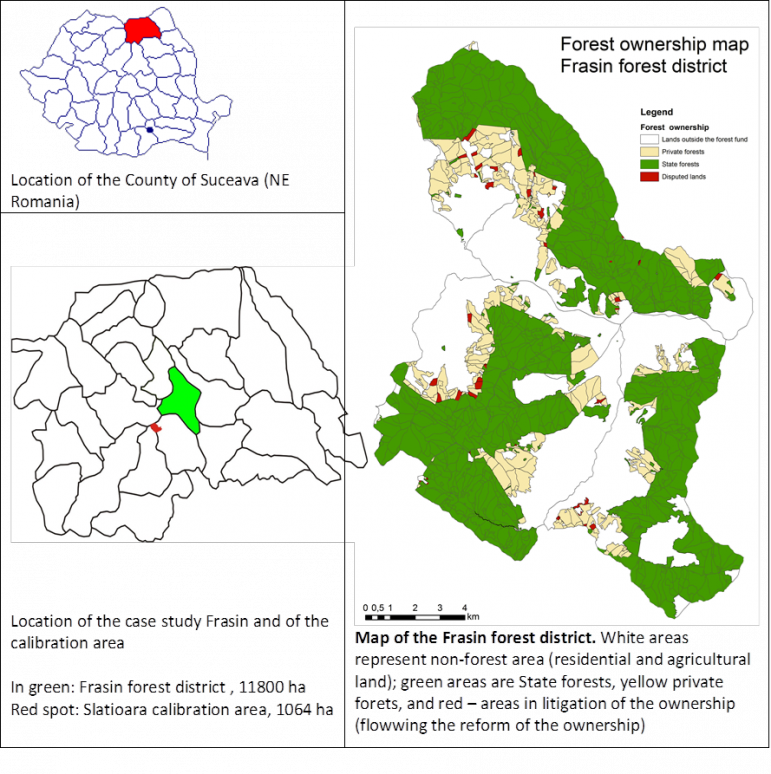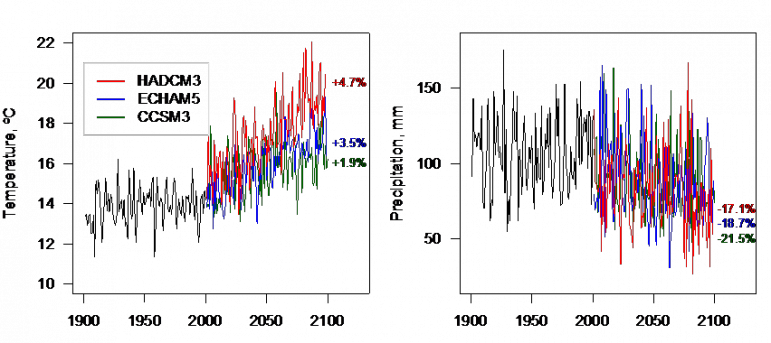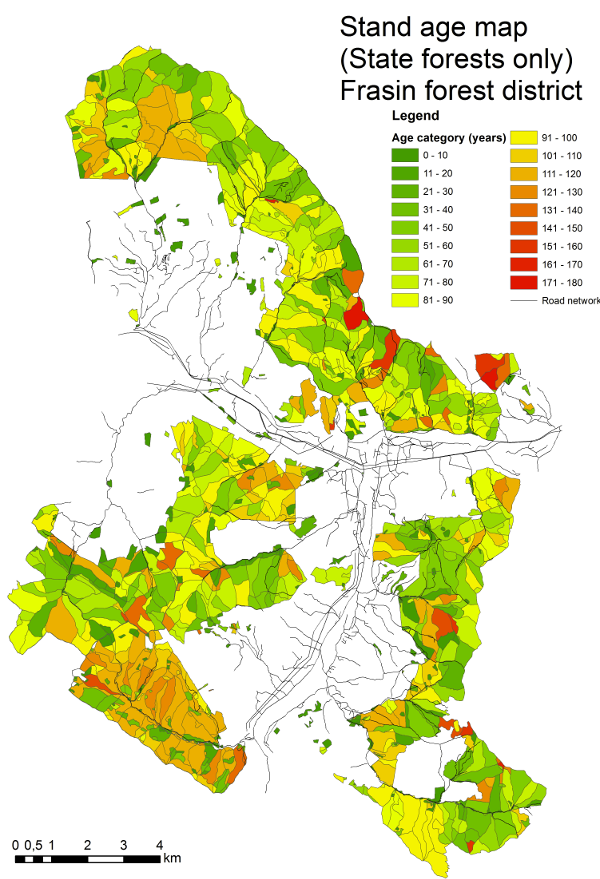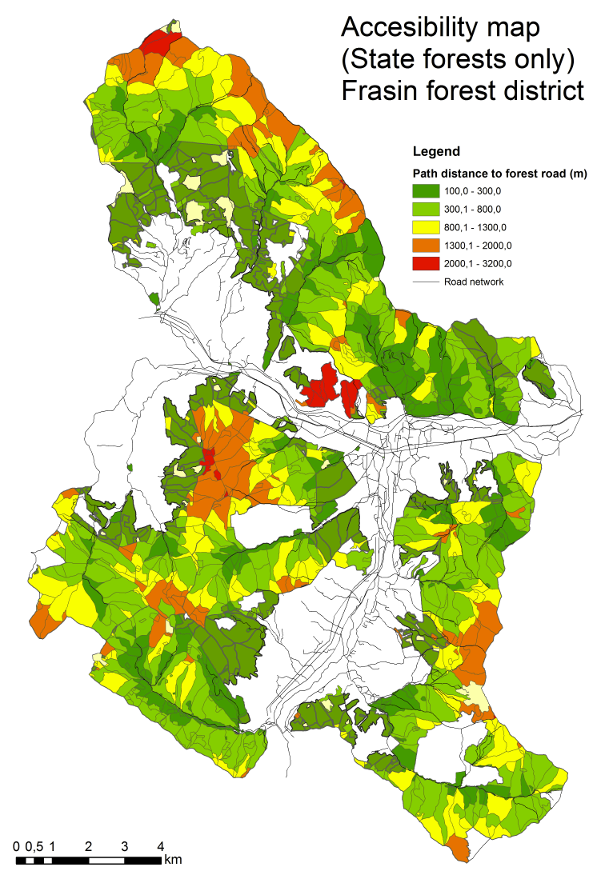General information about the case study
Slătioara Old-growth Forest is a Natural Reserve selected for model calibration for two reasons: i) its similarity with the Frasin case study in terms of forest and site characteristics; ii) the absence of human driving factors, and of several natural factors such windthrows and insect infection.
Frasin forests are situated mostly (90%) in mountain area. The main species are Norway spruce (Picea abies), beech (Fagus sylvatica) and silver fir (Abies alba). The deciduous species represents 27%. The age class distribution and the main objective of the forest management are presented below.
Table 1. Age distribution and the main function of the stands in Frasin forests (%)
| Age class (years) | 1-20 | 21-40 | 41-60 | 61-80 | 81-100 | 101-120 | 121-140 | 141-160 | 161-180 | Total |
| Production forests |
4,6 |
9,7 |
23,2 |
15,0 |
24,1 |
17,5 |
3,5 |
1,7 |
0,6 |
88,2 |
| Protected stands for seed production |
0,0 |
0,0 |
0,0 |
0,0 |
0,0 |
70,5 |
29,5 |
0,0 |
0,0 |
1,8 |
| Forest stands for soil protection |
4,5 |
12,4 |
7,5 |
21,3 |
17,6 |
23,3 |
12,6 |
0,8 |
0,0 |
9,8 |
| Entire Frasin forest |
4,6 |
9,8 |
21,2 |
15,3 |
23,0 |
19,1 |
4,9 |
1,6 |
0,6 |
100,0 |
The soil types do not show high spatial variability within the case study area, being rather good and middle productive, but soil depth varies with elevation. Three quarters of the forest districts has district cambisol. The nutrient content and availability is average, while the Water holding capacity and availability is high.
Table 2. Distribution of soil and stand type in Frasin forest
|
Stand type |
Stand structure |
Soil type (%) |
Total |
|||||
|
Luvisol |
Eutric cambisol |
Distric cambisol |
Spodisol |
Gleysol |
Technosol |
|||
| Norway spruce and silver fir stands |
Even-aged |
21,5 |
3,8 |
72,2 |
2,6 |
0,0 |
0,0 |
100,0 |
| Mixed Norway spruce, silver fir and beech stands |
Even-aged |
14,0 |
7,5 |
78,4 |
0,0 |
0,0 |
0,1 |
100,0 |
|
Uneven/aged |
22,3 |
12,7 |
64,9 |
0,0 |
0,0 |
0,2 |
100,0 |
|
Current climate, climate change scenarios
The region is generally characterized by a humid climate with harsh winters and cool summers, with a moderate regime of air temperature fluctuations and by mean annual thermal amplitude between 18 and 20 Celsius degrees. Late and early frosts are quite common. Most windthrows are caused by the west and north-west winds. Climate change scenarios for Romania forecast the increase of the average monthly temperature in all months, the highest increase being in July. On short term (2001-2030) the rainfall will decrease in average, the reduction being highest also in July. Specifically, for the case study area, and for the vegetation season, all the climate scenarios forecast an increase in the temperature (at least +1.9%) and a decrease of the precipitations (-17.1%) compared to the current climate (Figure 2).
Forest ownership in Frasin
The ownership of the Frasin area is divided between public forests (in green, Figure 1, left) and private forests. The district faced the typical restitution process after the year 1990. In three successive waves (1991, 2000 and 2005) the forest were given back to their former owners or inheritors, to the municipalities and to the forest communities. About 40% of the surface of the district was given back to the private owners. The location of the private forestlands was chosen by the specially created local commissions. Most of the private forests are distributed at the boundary of the State forests, in generally productive, low elevation sites located near the villages.
Public forest are hold by the State and municipalities while the private holders are represented by individuals, forest communities (common ownership), and the parishes. The main forest manager is Romsilva who manages 70% of the Frasin forests, e.g. the State forests and, on contractual basis, the forests belonging to other owners than the State. Ownership changes might still affect the forest district Frasin, because almost all the forestland is claimed back by an association representing the ancient Orthodox Churches Communities (Fondul religionar Ortodox) from Bucovina. Their claim to be entitled, formulated more than one decade ago, are still in Court litigation.
Stakeholder and demanded ecosystem services
In both forest districts, the forests were managed through forest management plans since long time – the XIXth century, while the Northern Carpathian was part of Hungary-Austria Empire. Today still the forests are managed on 10 years-based plans, the latest one being drawn in Frasin in 2009. The main purpose of the forest activities are the sustainable forest management, at least on the 70% of the land managed by Romsilva.
The main revenue-producing activity is wood production, 88% of the Frasin forests having production function. The harvesting (where, when, how) is regulated in the forest management plan on compulsory basis. The production of the Frasin forests is sold as standing timber (85%) and only 15% is sold as assortments on the forest roads. Around 15% of the timber sold by the forest district Frasin is bought by the local population for the energy purposes mostly (use of timber for the individual household heating system). Romsilva forest district sells the timber to private forest contractors, which are primarily small and micro size enterprises. The forest products and by-products will be sent to bigger economic agents (e.g. Schweighofer sawmill and Egger panel plants situated at 100 km distance). The timber industry complains however about the quality of the timber: the trees harvested are too old, too heavy, sometime of very low quality due to the insect and diseases attacks. Hunting represents a second economic activity after timber production. The rights to game management belong to the State, who will entitle the hunting organisations for practicing the game management in the Frasin hunting area. That may can create conflicts between hunting organisations and the private agricultural and forest owners. Non timber forest products are allowed for free harvesting, if they are collected for self consumption (except the grazing, the hunting and the fishing that are strictly regulated). The local population uses forests for picking up berries and mushrooms. At several points along the road linking Suceava from Campulung Moldovenesc, local inhabitants sell berries or mushrooms right next to the road from beginning of June to end September. Medicinal plants and wickers products from Frasin forests may also be found at the local markets.
Due to the dominance of the timber production, the main stakeholders are the owners (State, private, Frasin commune, parishes, forest communities) and the local timber harvesting and processing firms. Hunting associations and the local public administration (local major or counsellors) may eventually intervene in the local forest-related issues. The demand for ecosystem services is supposed to be supplied by the forest manager Romsilva through the implementation of the forest management plan. For this reason, almost 10% of the Frasin forests were set up as protective forests for preserving the soil resource against landslide, water erosion, and rockfalls. Several reserves for seed production were established also for the preservation of the genetic value of some Frasin forest stands (Figure 3).
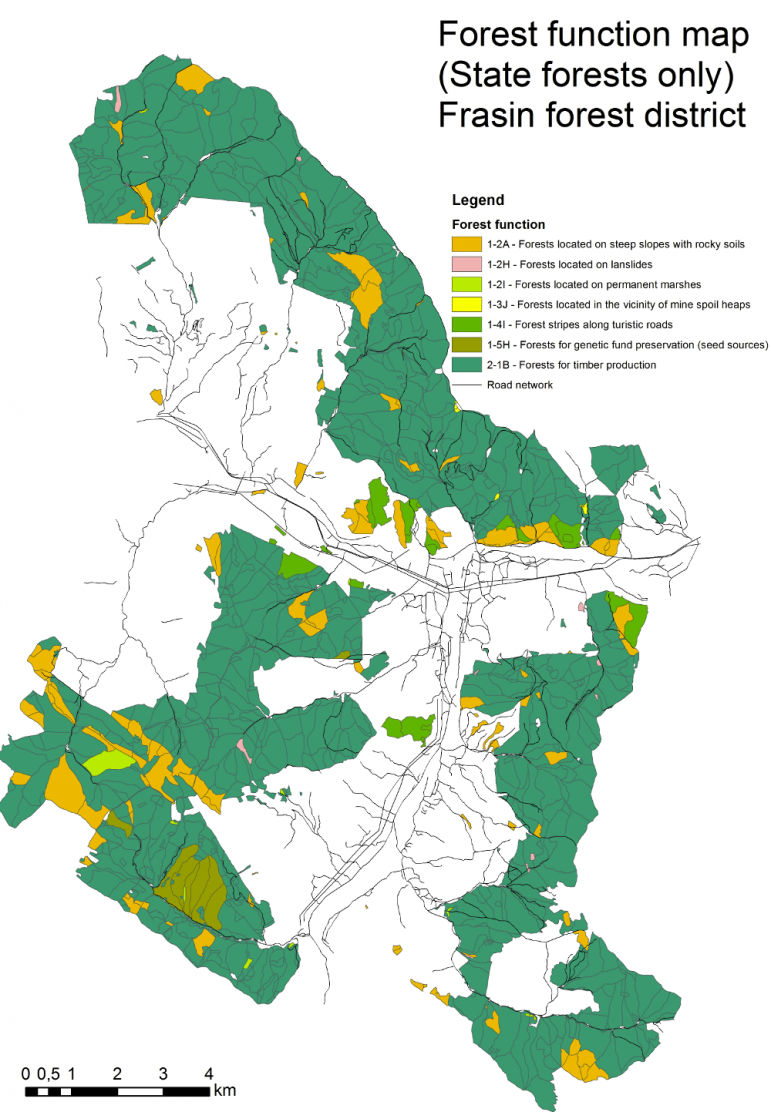
Figure 3. The main objective of the forest management. In dark green – forests for timber production.
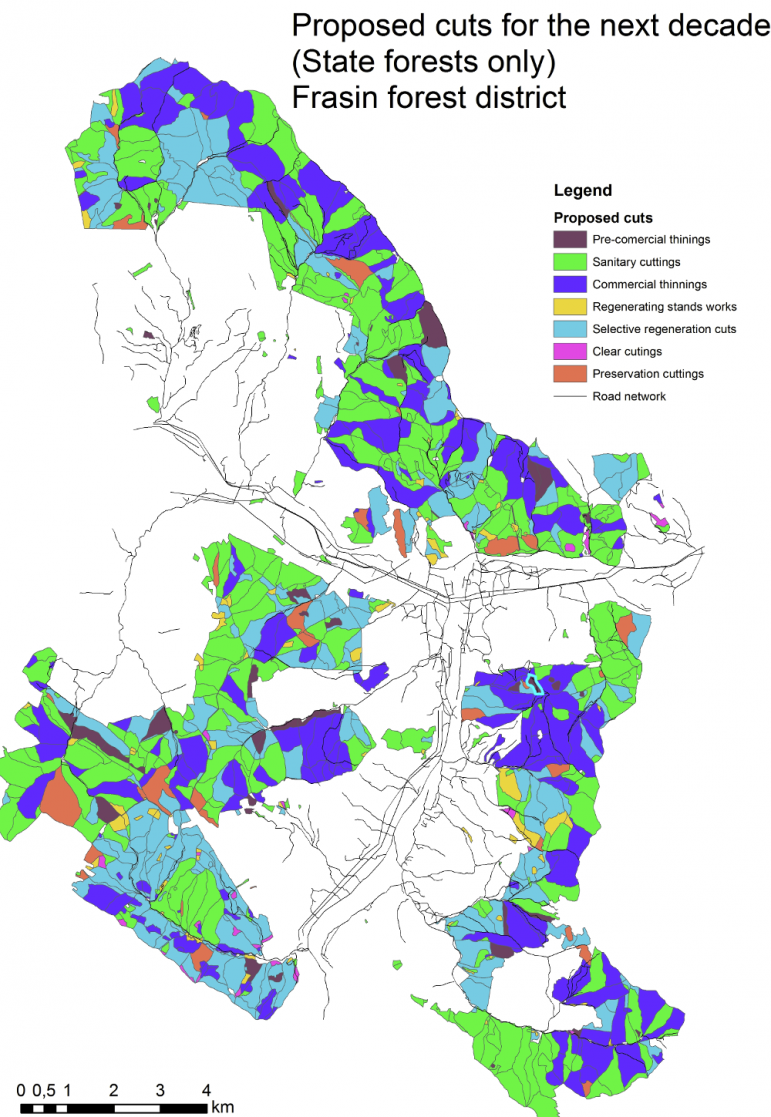
Figure 4. The forest management practiced in Frasin forests according to the objective of the forest management.
The goals of the forest management are contested by the forest owners, who complains that it is not fair to practice in the private forests the same forest management than in public forests, because it is too costly for them. The staff inside Romsilva also have the opinion that the rules are too bureaucratic, too rigid, and finally not adapted to a sustainable forest management, because they cut any flexibility of decision at the level of forest districts. The main conflict however is related with in the forest utilisation by the local people, interested in having a cheap or free access to firewood, grazing and non wood forest products, while the forest management tries to keep them away from forests, due to the risk of illegal logging, grazing damages and man-induced fire. The local relationships are complex, also due to the fact that many legal prescriptions are not respected, e.g. grazing in forests is prohibited, but it is practiced on large scale, even with goats, illegal logging is controlled, but the real extent can not be estimated, etc.
Are the tree species in the forest sensitive to climate change?
The typical stands in the case study area are composed of Norway spruce and beech, often in mixture. The tree species are sensitive to drought, windfall and insect attack.
The typical stands in the case study area are composed by Norway spruce, silver fir and beech, often in mixture. Beech, followed by silver fir is sensitive to drought and the Norway spruce is the most sensitive to windfall and insect attack.
Although there is much empirical evidence of frequent drought episodes, there are no studies available to quantify and detail droughts in this region. The discussions with the forest management authorities in the case study area identified drought as being an increasingly important factor for tree stress, potentially leading to dieback. Beech is widely known as a drought-sensitive species, and would likely respond to more frequent or intense droughts by reducing its productivity. The Norway spruce growing in mixture with other coniferous species in the region had the strongest reaction to drought. The consequences could be a drop in productivity but also an increase in trees’ susceptibility to insect attacks.
The stands can be regenerated naturally or with some planting complements. However, a shift in species composition could be observed in the future, as beech tends to gain space to the detriment of Norway spruce, but there are not enough evidences to put this shift to the climate change.
The Norway spruce and larch are sensible to the insect attack moth Lymantria monacha. Attacks on Norway spruce during an outbreak can lead to total defoliation. Trees with defoliation exceeding 30% are unlikely to recover. Total or partial defoliation weakens trees and promotes secondary pest attacks (e.g. from bark beetles). Major bark beetle attacks (in the last 10 years) have been reported since 2003, when outbreaks of insect populations followed the existence of a large quantity of breeding material from the 2002 windfall. A high level of bark beetle population persisted until now, with a large number of healthy spruce trees being attacked annually. The damage can potentially be considerable, with several thousands m3 of wood to be cut.
Will the risk profile of tree species change under climate change?
Wind throw is expected to have an increasing impact in the disturbances regime, and to affect larger area (to have an increased frequency of the catastrophic events). There is a significant risk that the areas affected by the wind throw would be difficult to regenerate with the main tree species, if climate is warmer (risk of drought). We have in the site examples from private forests cut down ten years ago, and still not regenerated, or regenerated with pioneer species like birch, aspen or willow.
For Norway spruce there will be an increasing bark beetle infestation risk. Fire risk will increase on Norway spruce stands in a warmer and drier climate. Fire starts usually in the spring time when the landowners are cleaning the arable/grazing lands by fire and it happens that the fire spread out in the forests nearby.
The temperature increase considered by the climatic scenario becomes a handicap for Norway spruce which will suffer or lose the competition with the other species naturally regenerated.
Assume that current management (BAU) is continued: Is it possible to achieve current goals also under climate change conditions?
The Frasin forest managers consider that stands are not particularly vulnerable to climate change. However some stands are more exposed to illegal logging, some other to forest fire, or other to grazing, which act as man-related disturbances able to amplify the negative effect of the climate change. Also, the uncertainty of the ownership created and will still create pressure on the forest management, e.g. attempt to harvest more than allowed.
The managers listed some additional risks that are related with the forest management practiced today. For example:
- the current management of the stands density: the stands are too dense;
- the production-oriented goals today do not meet anymore the economic demand or the ecological requirements: the stands are managed in long rotations and large tree sizes that is inducing a risk for unstable stands (too old) in the future, and are not satisfying neither the demand of the timber processing industry.
- The managers have started to have difficulties in regenerating the forests and in controlling the insects development, e.g. the bureaucracy of timber harvesting make impossible a fast intervention to cut infested trees and quickly stop insects development.
Thus, if there are not stands particularly vulnerable today, a combination between the current management risks and man-induced disturbances and the effect of the climate change may have serious consequences in the future. Then the natural drivers will make improbable the achievement of the current management goals. On the one hand, the economic difficulties encountered already today by the managers (they called the forestry practiced as being “subsistence forestry”) will increase with increasing disturbances, costs to fight attack insects and costs to regenerate the forests. On the other hand, the protective functions of the forests can not be achieved anymore if, for example, wind throw will happen on larger scale. The frequency and the quantity of timber extracted as salvage operations will increase and that will affect the planned harvest schedules. Nevertheless, the biodiversity is expected to increase following the different disturbances that are likely to occur (Table RO-1). Larger scale of windthrow will benefit to the regeneration of tree species that are now rare, e.g. birch, larch, horn bean, even oak, supplying then richer conditions for different animal species. In the BAU management, the biomass volume is quite similar to the current situation. The managers will have to face the reduction/disappearing of the Norway spruce and the apparition of pioneer species (Betula pendula, Salix) that will represent almost half of the biomass produced. Thus, due to the new species composition, there will be a significant decrease in the supply of wood for the market.
Table RO-1. Impact of the expected climate change on different forest ecosystem functions in Frasin forests (+ positive impact, — negative impact, * indifferent) for Business as usual 2100, ECHAM5 climate change scenario.
| Forest ecosystem functions |
2020-2050 |
2050-2100 |
| Timber production (allowed harvesting according to the Forest Management Plans) |
— (after the extraction of the old stands |
— (due to the new species composition, |
| Biodiversity |
+ |
+++ |
| Soil protection (if minor or no disturbances) |
+++ (better, due to the regeneration |
+++ (better, due to the regeneration |
| Soil protection (if large scale disturbances, e.g. windthrow, bark beetle infestation) |
— (worst than today, if regeneration do not happen |
— (worst, if regeneration do not |
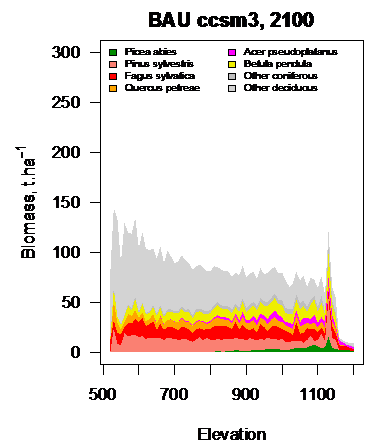
Figure RO-1. BAU management will lead to an decrease of the timber production, but an increase of the biodiversity
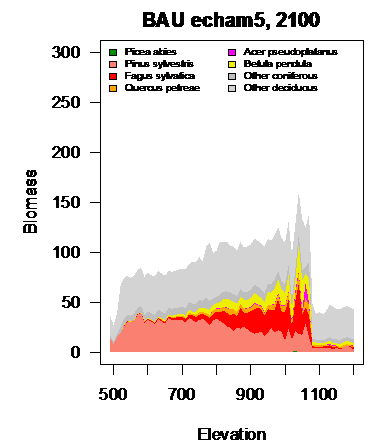
Figure RO-2. BAU management will lead to an decrease of the timber production, but an increase of the biodiversity
A particular problem comes from the age structure of the stands today in the Frasin forests (Figure RO-3). The current age class distribution is particularly unbalanced: at the beginning of the simulation (2000), half of the stands are more than 70 years old and a third more than 90 years. The excess of the over-mature stands will impose to the forest manager to progressively harvest the stands in order to distribute the harvesting of the old stands in tree-four decades. If climate change happen, the forest manager will not be able anymore to decide which stands to harvest, because he will be obliged to harvest according to the disturbances occurred. Current goals such regeneration after final cutting or spatial optimisation of cuttings for better soil protection may become impossible to achieve. The present old stands may remain un-harvested, therefore more vulnerable to new disturbances, also due to the accessibility of the stands, which is quite low (Figure RO-4).
How did you come to your conclusion(s)? Which tools and methods did you employ?
Landscape level model LandClim was used to simulate forest ecosystem dynamic. Adaptative management were explored using the harvest module by defining potential management scenarios for each management unit within the forest district studied following the silvicultural trends. The simulations was run on the forest district landscapes designed from a digital elevation model, stand and soil information, climate data and forest ownership maps.
The data from the management plans produced before 1989 were used to initialize the private stands. A first run enabled to simulate the current starting state of these stands, after they had been aged for 2 decades by the model.
The model did not deal specifically with the uncertainties.
Which obstacles are limiting the implementation of adaptive management?
For the introduction of new broad-leaves species there are currently two contradictory trends, and therefore two kind of obstacles. In one hand it seems that broadleaves are coming back and are replacing Norway spruce, at least in clear cut areas formerly composed by Norway spruce stands. The preliminary results of on-going sociological inquiries in the area show that forest managers tend to prefer the Norway spruce in the regeneration and to neglect/eliminate if possible in prunning/cleaning/thinning the other species. On the other hand, it seems that under the shelter-wood cutting system, largely practiced and prescribed in the management plan, the broadleaves species (excepting beech) do not succeed to regenerate, a recent phenomenon (about ten years). One explanation that may be provided is the existing browsing/grazing that concentrate on the patches of broadleaves resulted after the regeneration works (Schultze, personal communication). Thus we may underline that for the changes in the species composition the main obstacle are: 1) the forest managers (and owners) preference for Norway spruce, more income-promising than beech-based stands, and 2) the high browsing/grazing pressure that can not be easily solved.
The obstacles are different when the solution proposed concerns the reduction of the harvesting age (rotation length) or the increase of the thinning intensity. The harvesting age is determined in the forest management plan as implementation of very strict rules with law force. The harvesting age is established according to the type of the stand (composition, productivity) and the forest ecosystem functions. Therefore there is a legal obstacle for modifying the harvesting age, because it is established by law, compulsory for all forest owners, and can not be modified locally according the forest managers’ experience or owners’ needs in terms of wood assortments. The same obstacle applies for the thinning intensity which is not as strictly imposed by the technical norms as the rotation age but rather it is a consequence of practitioners’ fear to act by their experience (they prefer to use some average values recommended by norms). Another obstacle related to thinning is the low value of wood that make the works unattractive for the harvesting companies, particularly if the thinning has to be done in stands with low accessibility or strong slopes. We expect that the problem of too low thinning intensity and frequency will not be solved soon.
Finally, several obstacles may affect the forest managers capacity to react and to adapt, e.g. too long and bureaucratic process for obtaining the permit to harvest the infested trees and stands in case of insect attacks; lack of forest road infrastructure (national average is 5.6 m of forest road per ha) that limit the forest managers capacity to intervene in case of disturbances; unbalanced age structure that offers little room to adapt the management once the harvesting is done.
